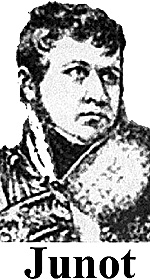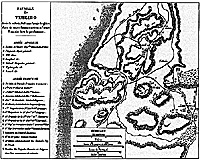This article is a follow on to my feature on Rolica in FE14, and for those unfamiliar with the events prior to Vimeiro I would recommend a quick glance at that issue.
 On August the 18th, 1808 following his defeat at Rolica, General Delaborde rallied his division on General Junot's main force at Torres Vedras giving Junot an up to date and accurate account of Wellesley's army, although it should be borne in mind that Delaborde greatly exaggerated the losses he had inflicted on the British. Amongst Junot's force was Loison's division, which had of course been expected by both sides to attend Rolica. In fact whilst Rolica was under way Loison was only 15 miles away and within the sound of the guns, but like another Frenchman 7 years later chose to ignore them.
On August the 18th, 1808 following his defeat at Rolica, General Delaborde rallied his division on General Junot's main force at Torres Vedras giving Junot an up to date and accurate account of Wellesley's army, although it should be borne in mind that Delaborde greatly exaggerated the losses he had inflicted on the British. Amongst Junot's force was Loison's division, which had of course been expected by both sides to attend Rolica. In fact whilst Rolica was under way Loison was only 15 miles away and within the sound of the guns, but like another Frenchman 7 years later chose to ignore them.
Junot was thus left with the lingering impression that Wellesley's men had taken a good hiding and that morale was subsequently low. He duly reorganised his troops into two infantry and one cavalry divisions under Loison, Delaborde and Margaron respectively. He furthermore retained a reserve of four converged grenadier battalions. In the British camp, meanwhile, Wellesley was uncertain of where the French had gone but was expecting to contact Junot fairly shortly and he remained on the field of Rolica overnight awaiting reinforcements which were due by sea. These arrived the following morning and were ordered to disembark at Porto Novo where the Maceiro river met the coast and from where Wellesley could protect them by moving to Vimeiro, east of the landing. Margaron's troopers reported this movement to Junot who mistakenly believed that the British were merely resupplying and despite already being slightly outnumbered he ordered his army to advance on the evening of August the 20th.
Landed
By this time both Anstruther and Acland had landed their brigades and Sir Arthur had already made his mind up to attack Junot who he had finally located at Torres Vedras! Unfortunately at this point General Sir Harry Burrard arrived aboard a Royal Nay frigate and during an on board interview with Wellesley, his junior, he ordered the appalled Sir Arthur to halt in his tracks and await further reinforcements who bore with them another prize oaf, General Dalrymple who was to supersede Wellesley. Inadvertently Burrard had done Wellesley a huge favour by allowing Junot to come onto him instead of vice versa and he compounded it by deciding to stay in comfort one more night on the frigate and leave the army to Wellesley.
Due to the comparative uselessness of the British scouting cavalry Wellesley had no idea Junot was advancing until the early hours of the 22nd August and he immediately ordered the Redcoats to stand to and expect a dawn attack. Conversely Junot, who had intended such an attack found his troops so disordered by the terrain that he ordered a halt prior to reaching Vimeiro so that they could form up and have a bite to eat.
Because he had been expecting to attack and not defend Wellesley's dispositions around Vimeiro were not ideal for defence. Two brigades were exposed on the Vimeiro Hill with the precious transport park to their rear. Apart from Two further brigades on the Eastern Ridge the remainder were scattered over the Western Ridge. Junot himself intended an aggressive assault based on wrong information that the British northern flank extended for several miles. He thus intended to split the British in two and seize their landing are, forcing a capitulation. This necessitated a flank march across Wellesley's front but Junot was contemptuous of the British troops capacity to react to him.
March
Consequently the British general watched the French columns crossing his open flank to stop east of Vimeiro Hill except for Brennier's brigade which carried on to the north. Not for the last time a French commander seriously underestimated Wellesley's ability, for practically at once Sir Arthur gathered his opponent's plan and began to reposition his troops accordingly. Fane and Anstruther were to remain at Vimeiro with Hill on the Western Ridge.
Trant and Crawford were dispatched north to cover Brennier's movements whilst the remaining brigades were deployed along the Eastern Ridge. For his part Junot saw part of the British manoeuvre and sent Solignac's brigade to reinforce Brennier. He then ordered Charlot and Thomieres to attack Vimeiro supported by only 7 guns, keeping the cavalry, grenadiers and remaining artillery as a reserve.
This attack went forward under much harassment from Fane's riflemen, pausing to reorder at the base of the slope and being met by a rather nasty volley at just under 100 yards. Whilst the columns halted, again the British rather unsportingly advanced to point blank range and gave them another taste of it. The French promptly routed back until rallied by Junot's reserve, losing all 7 guns in the process. Not satisfied, Junot determined to launch a second attack with Kellerman's and St Clair's grenadiers, reinforced with the two already battered line brigades. Regrettably, for Junot's chances of joining the Marshalate, this attack diverged and went in uncoordinated. St Clair's brigade contacted first attacking through the carnage of the first assault supported by Margaron's cavalry who kept the riflemen at a more respect-able distance. However, once within musket range the grenadiers were unable to stay with the Redcoats whose fire drove them into the shelter of pine trees which littered the bottom of the slope. Kellerman meanwhile was advancing along a sunken road which would bring him into Vimeiro and onto the transport park.
Realising this Anstruther moved the 2/43rd Foot to prevent this and Wellesley supported this by moving Acland forward to flank the French. Because of the nature of the terrain the British were unable to indulge in the usual short range firefight and instead a nasty bayonet action took place between the 2/43rd and the French grenadiers. Both sides lost in excess of 100 men before the grenadiers had taken enough and retired gracefully. Seeing this Wellesley launched his meagre cavalry in pursuit, the 20th Light Dragoons doing much damage to the grenadiers before going out of control and getting mauled in turn by Margaron's dragoons. The Portuguese cavalry who were to have supported this decided that retreating grenadiers looked like too much of a handful and they retired instead.
At this moment Burrard arrived but somewhat surprisingly allowed Wellesley to retain battlefield command. Perhaps he was confused by seeing so many troops actually fighting.
What befell the two brigades sent at intervals north, you may be asking. Brennier, in the lead followed the road rather than crossing the stream near Toledo where ordered as he considered the terrain unsuitable for artillery. Not so Solignac, who crossed further on where the going was easier and thus inadvertently went into action before Brennier. Advancing on the farm of Ventosa all Solignac could see was a thin skirmish screen and accordingly his three screened battalions advanced towards them with some confidence. This charming illusion was shattered when three British brigades, those of Ferguson, Bowe and Nightingall decided to stand up from where they had been lying - behind the crest and directly in front of Solignac.
The first volley practically annihilated the French skirmish screen and the second one broke the whole brigade, wounding it's commander in the process. In the ensuing rout all three of Solignac's guns were captured. Marching to the sound of the fighting Brennier arrived to the surprise of the British who rallied back preparing for another fight. In the short fight that followed Brennier was wounded and captured and his brigade quickly retreated, leaving their artillery to the British once again.
As Junot began to retreat, Wellesley learnt from the wounded Brennier how spent the French were and he decided to advance at once to take Torres Vedras. Unfortunately this was not to be as Burrard stepped in and ordered an immediate halt, allegedly because of poor supply but more likely because he was a complete idiot. The French thus escaped unpursued, much to Wellesley's disgust. If he thought that was bad then he did not know what was to follow with the Convention of Cintra...
British casualties in the battle were between 706 and 720 killed, wounded and missing. French figures are less accurate but were between 1500 and 2000 killed, wounded or captured and 15 guns taken.
Large Map (slow: 150K) At the foot of its eastern slope is a pine wood. The River Maceira can be crossed only at bridges, unlike the stream which is fully fordable. All the villages should be regarded as small with stone buildings.
Objective
Wellesley's objective should be to prevent the French reaching the landing beach in his rear and preferably not to allow his army to be split. Junot's objective is to split Wellesley's army and drive in on his beachhead, effectively denuding the British of supply and forcing a surrender.
As with Rolica, the British artillery teams are in an awful state and should move at infantry line speed. They should take treble time to limber up once unlimbered. No formed troops should be allowed through the transport park other than in road column. At 1200 Sir Harry Burrard should appear, (the umpire should keep this from Wellesley) pick the least popular bloke in the group (this should be kept from him) to play Burrard and tell him he can do what he wants as long as he does not order any charges. Then have his orders carried out to the letter.
As for the French you have two options. Either a fully historical deployment with Brennier marching off to the north or allow the French player to see Wellesley's dispositions and make up a plan for himself. Hidden deployment for parts of the British might well be employed in this case to confuse the dastardly French!
WARGAMING VIMEIRO

Jumbo Map (slow: 348K)
Unlike Rolica, this battle is more broken up and could in theory be fought in two separate sections. However, for those who like me prefer their battles whole here is a description of the salient terrain features. The Western Ridge is the most complicated terrain piece, being steep on its southern side and practically impassable to the West, whilst the top is relatively flat and open. The Eastern Ridge in contrast is relatively gentle and should prove less difficult for troops to negotiate. Its top is also flat. Vimeiro Hill is lower than the two ridges and has a proper crest line.
Back to Table of Contents -- First Empire #16
Back to First Empire List of Issues
Back to MagWeb Master Magazine List
© Copyright 1994 by First Empire.
This article appears in MagWeb (Magazine Web) on the Internet World Wide Web. Other military history articles and gaming articles are available at http://www.magweb.com